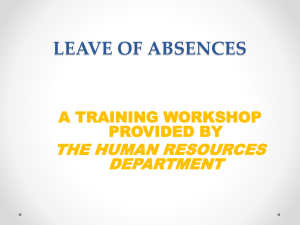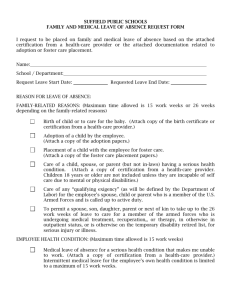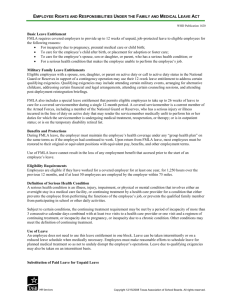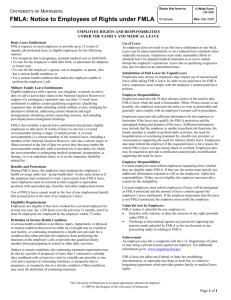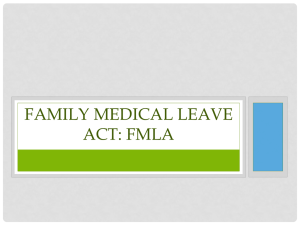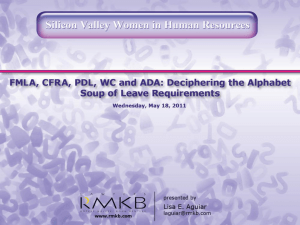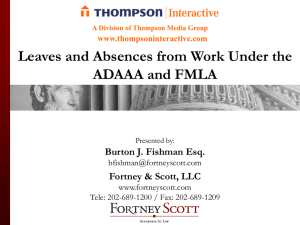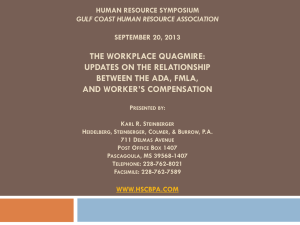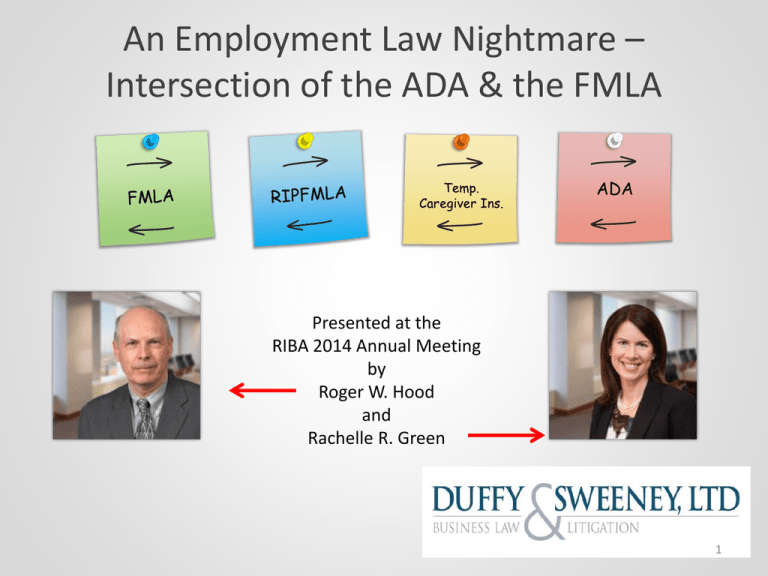
An Employment Law Nightmare –
Intersection of the ADA & the FMLA
ADA
Presented at the
RIBA 2014 Annual Meeting
by
Roger W. Hood
and
Rachelle R. Green
1
Family Medical Leave Act (“FMLA”)¹
• Basic Rule:
Covered employers
must allow eligible employees to
take up to 12 weeks of job-protected
leave in a 12-month period to be
used for certain qualifying events.²
• Special rules apply to families of
military service members or veterans,
as
well
as
airline
flight
crew
employees.
2
FMLA: “Covered Employers” & “Eligible Employees”³
Covered Employers
Eligible Employees
Company has 50 or more
employees
Must have worked at company
for 12 months
Includes part-time workers,
temporary workers, and
workers on paid and unpaid
leave
Short breaks in service do not
interrupt employee eligibility
Employee must work at U.S.
location where the company
employs at least 50 workers
within a 75-mile radius
Must have actually worked
1,250 hours during the prior
12-month period
3
Methods of Calculating 12-month Period⁴
Employers may select one of four methods to
calculate the 12-month period to be uniformly
applied to all employees taking FMLA leave:
1. Calendar year: January 1 to December 31
2. Any fixed 12-months: fiscal year, year
starting on employee’s anniversary of
hire; or any other 12 month period
3. 12-months measured forward: measured
from the first date an employee takes
FMLA leave
4. “rolling” 12-months measured backward:
each time an employee takes leave, the
remaining leave would be the balance of
the 12 weeks not used during the
preceding 12 months
4
FMLA: “Qualifying Events”⁵
Birth of newborn child
Placement with employee of adopted or foster
child
Leave to “care for” a serious health condition of
employee’s spouse, child, or parent
Employee’s serious health condition
Event related to covered military service of
employee’s family
“qualifying exigency” (12 weeks of leave)
military
caregiver
leave
for
service
member or veteran’s serious illness or
injury (26 weeks of leave)
5
FMLA: “Serious Health Condition”
Means: Illness, injury or physical or mental
condition that involves either:
inpatient care; or
continuing treatment by a health care
provider
Inpatient care includes an overnight stay at a
hospital, hospice, or residential treatment facility.
6
FMLA: Qualifying Family Relationships
Spouse: husband or wife, as determined by state
law
Parent: biological, adoptive, or any person who
assumed parental duties while employee was a
child
Child:
biological, adopted, foster, step, or legal
ward if under 18 years old; also includes child
under age 18 for whom employee has assumed
parental duties, including financial support.
If
disabled, includes children over age 18.
7
FMLA: Duration of Leave
General Rule: Eligible employees may take up to
12 weeks of job-protected, unpaid leave during
any 12-month period.
Intermittent leave may be taken for serious health
condition if medically necessary (e.g. several days
or hours per month for chemo or dialysis), but not
for birth or adoption.⁶
FMLA leave is unpaid leave. Employer may
require employee to substitute available paid
leave for unpaid leave
8
FMLA: Prohibits Retaliation for Taking Leave¹³
Employer may not “interfere” with employee’s right
to FMLA leave or terminate employee for taking
FMLA leave.
Consider:
Timing of discipline
Treating
employees
who
have
taken
FMLA leave differently
Failing to document discipline
Employees
who
cannot
perform
essential
functions of their jobs at the end of FMLA are
not entitled to job restoration. However, they may
be entitled to additional leave as a reasonable
accommodation under the ADA.
9
Rhode Island Parental & Family Medical Leave Act¹⁴
Basic Rule:
Covered employers must allow
employees to take 13 consecutive work weeks of
parental leave or family leave in any two
calendar years.
If leave is covered by both FMLA and RIPFMLA,
the leaves run concurrently unless otherwise
provided in the employee handbook.
In the event of inconsistencies, the employer must
apply the provision that is more beneficial to the
employee.
10
Federal vs. RIPFMLA
FMLA¹⁵
RIPFMLA¹⁶
Amount of Leave
12 weeks unpaid leave in a 12month period
13 consecutive weeks
unpaid leave in any 2 years
Leave Year
Calculations
Can use:
Calendar
Fixed Year
Rolling Forward
Rolling Backward
Calendar year
“Covered
Employer”
Employers with 50 or more
employees during the leave
year or prior year
Employers with 50 or more
employees
11
Federal vs. RIPFMLA
Eligible
Employees
FMLA
RIPFMLA
12 months of service
1,250 hours of service during the
12 months preceding the leave
at worksite with 50 or more
employees within 75 miles of the
worksite
12 consecutive months
of service
works an average of 30
or more hours per week
Covered
Child (biological, adopted, step,
Relationships
foster, legal ward, or in loco
parentis) under age 18 or
incapable of self-care due to
disability
Spouse (husband or wife, but not
domestic partner/civil union)*
Parent (biological, adoptive,
foster, step, or in loco parentis)
Child (undefined)
Spouse (husband or
wife, as defined by RI
law)**
Parent (undefined)
Parent-in-law (motheror father-in-law)
*But see: Windsor v. United States
**Rhode Island recognizes same sex spouses. See R.I. Gen. Law § 15-1-1.
12
Federal vs. RIPFMLA
FMLA
RIPFMLA
Mode of Leave
Usage
Continuous
Intermittent
Reduced schedule
Continuous
Health Insurance
Benefits
Employer must continue
coverage and pay employer’s
share of premium. Employee
still responsible for share of
premium (if any).
Same, except that RIPFMLA
requires employee to pay in
advance the amount of
premiums required to
maintain benefits during
the leave
Reinstatement
Following leave, employee
must be restored to the
same or equivalent
position.
Exception for “key
employees”
Same, except that RIPFMLA
does not have an exception
for “key employees”
13
Federal vs. RIPFMLA
FMLA
RIPFMLA
Pre-Leave
Notice
Required
30 days prior notice for
foreseeable leave, and if
leave is unforeseeable, as
much notice as practicable
30 days prior notice “unless
prevented by medical emergency
to provide said notice”
Request for leave must verify the
truthfulness of the factual
representations made by
employee and include a detailed
description of employee’s
entitlement to leave
Medical
Certification
Employer may require
certification of the patient’s
medical condition by
healthcare provider
Employer may require certification of
healthcare provider of the “probable
duration” of the leave
14
Rhode Island Temporary Caregiver Insurance (“TCI”)17
Effective January 1, 2014, Rhode Island employers
must allow their employees four (4) weeks of time
off per year to care for a family member with a
serious medical illness or to bond with a child
within the first 12 months of parenting.
Applies to all employers regardless of size.
Covers all employees regardless of how long they
have worked for the employer.
15
Rhode Island Temporary Caregiver Insurance (“TCI”)
During TCI leave, the employer does not pay
salary, but employees receive temporary disability
insurance payments from the state.
During TCI leave, the employer must continue to
provide health insurance to enrolled employees,
but the employee is responsible for its share of
health insurance premiums (if any).
Employer has no right to request certification of the
employee’s relationship to the ill family member or
of the family member’s serious health condition.
Employee provides documentation to the state.
16
Americans with Disabilities Act
(“ADA”)18
•
Basic Rule: an employer with 15 or more employees shall not discriminate against a
qualified individual with a disability.
•
The ADA makes it unlawful to discriminate in all employment practices such as:
Recruitment
Hiring
Training
Job assignments and promotions
Pay and benefits
Leave
Termination
17
ADA: What is A Disability?
• A person has “disability” if he or she has (1) a physical or mental
impairment that substantially limits one or more major life
activities; (2) a record of this impairment; or (3) is regarded as
having such an impairment.¹⁹
• Examples of major life activities include: standing, sitting, lifting,
seeing, hearing, eating, caring for oneself, working, walking,
reading,
concentrating,
performing
manual
tasks,
or
communicating.²⁰
18
ADA: Substantially Limiting²¹
A person has “disability” if he or she has (1) a physical or mental impairment that
substantially limits one or more major life activities; (2) a record of this impairment; or (3)
is regarded as having such an impairment.
•
Ability to perform a major life activity is measured against the average person’s ability.
•
Corrective measures must not be considered, except for ordinary eye glasses and
contact lenses.
•
Requires an individualized assessment:
nature and severity of the impairment
impairment’s permanent or long-term impact
transitory impairments are not covered, but episodic or in remission are covered
19
ADA: “Record of” or “Regarded” as Disabled22
A person has “disability” if he or she has (1) a physical or mental impairment that
substantially limits one or more major life activities; (2) a record of this impairment;
or (3) is regarded as having such an impairment.¹
•
Record of impairment:
Document indicates an impairment that would substantially limit one or more
major life activities.
Covers those with a history of having such an impairment.
•
“Regarded” as disabled is based on the perceptions of others.
20
ADA: Who is qualified?
Basic Rule: an employer with 15 or more employees shall not discriminate against a
qualified individual with a disability.
•
An individual with a disability is considered qualified if the individual, with or
without reasonable accommodation, can perform the essential functions of the
job held or desired.23
•
Reasonable accommodations to the known physical or mental limitations of a
qualified employee or applicant with a disability must be made unless to do so
would cause undue hardship on the operation of the employer’s business.24
•
Undue hardship includes employer’s cost, onsite resources, overall resources, and
nature of operations.25
21
ADA: Reasonable Accommodations
•
Contemplates an Iterative Process
•
Types of Accommodations:
required in the employment process for qualified applicants
make it possible for employees with disabilities to perform the essential functions of the
position held or desired
enable employees with disabilities to enjoy the benefits and privileges of employment
that are equal to (rather than the same as) the benefits and privileges that are enjoyed
by other employees
Time off from work (either a modified schedule or flexible leave policy) may be required
as a reasonable accommodation.
22
ADA: Prohibits
Discrimination/Retaliation
•
Discrimination may include: denying employment opportunities to qualified
individuals; failing to make reasonable accommodations for the individual’s known
physical or mental limitations; and/or terminating an employee for requesting a
reasonable accommodation.
•
Employees with disabilities may be disciplined like any other employee.
•
Employees with disabilities may not be disciplined if the employer has refused to
provide a reasonable accommodation and the reason for unsatisfactory
performance was the lack of accommodation.
•
Employees with disabilities may not be terminated for requesting a reasonable
accommodation.
23
End Notes
1.
2.
3.
4.
5.
6.
7.
8.
9.
10.
11.
12.
13.
14.
15.
16.
17.
18.
19.
20.
21.
22.
23.
24.
25.
29 U.S.C. § 2601 et seq.
29 U.S.C. § 2612.
29 U.S.C. § 2611.
29 C.F.R. § 825.200; see also U.S. Dep’t of Labor Fact Sheet No. 28H (available at
http://www.dol.gov/whd/regs/compliance/whdfs28h.pdf).
29 U.S.C. § 2612.
29 C.F.R. § 825.202.
29 C.F.R. § 825.300.
29 C.F.R. § 825.305.
29 C.F.R. § 825.305.
29 C.F.R. § 825.311.
29 U.S.C. § 2614(a).
29 U.S.C. § 2614(b).
29 U.S.C. § 2615.
R.I. Gen. Laws § 28-48-1 et seq.
29 U.S.C. § 2601 et seq.
R.I. Gen. Laws § 28-48-1 et seq.
R.I. Gen. Laws § 28-41-34.
42 U.S.C. § 12101 et seq.
42 U.S.C. § 12111(5)(A).
42 U.S.C. § 12102(1).
29 U.S.C. § 1630.2(i).
29 C.F.R. § 1630.2(k)-(l).
29 C.F.R. § 1630.2(m).
29 C.F.R. § 1630.2(o).
29 C.F.R. § 1630.2(p).
24
An Employment Law Nightmare –
Intersection of the ADA & the FMLA
ADA
Presented at the
RIBA 2014 Annual Meeting
by
Roger W. Hood
and
Rachelle R. Green
25
YOU
26

